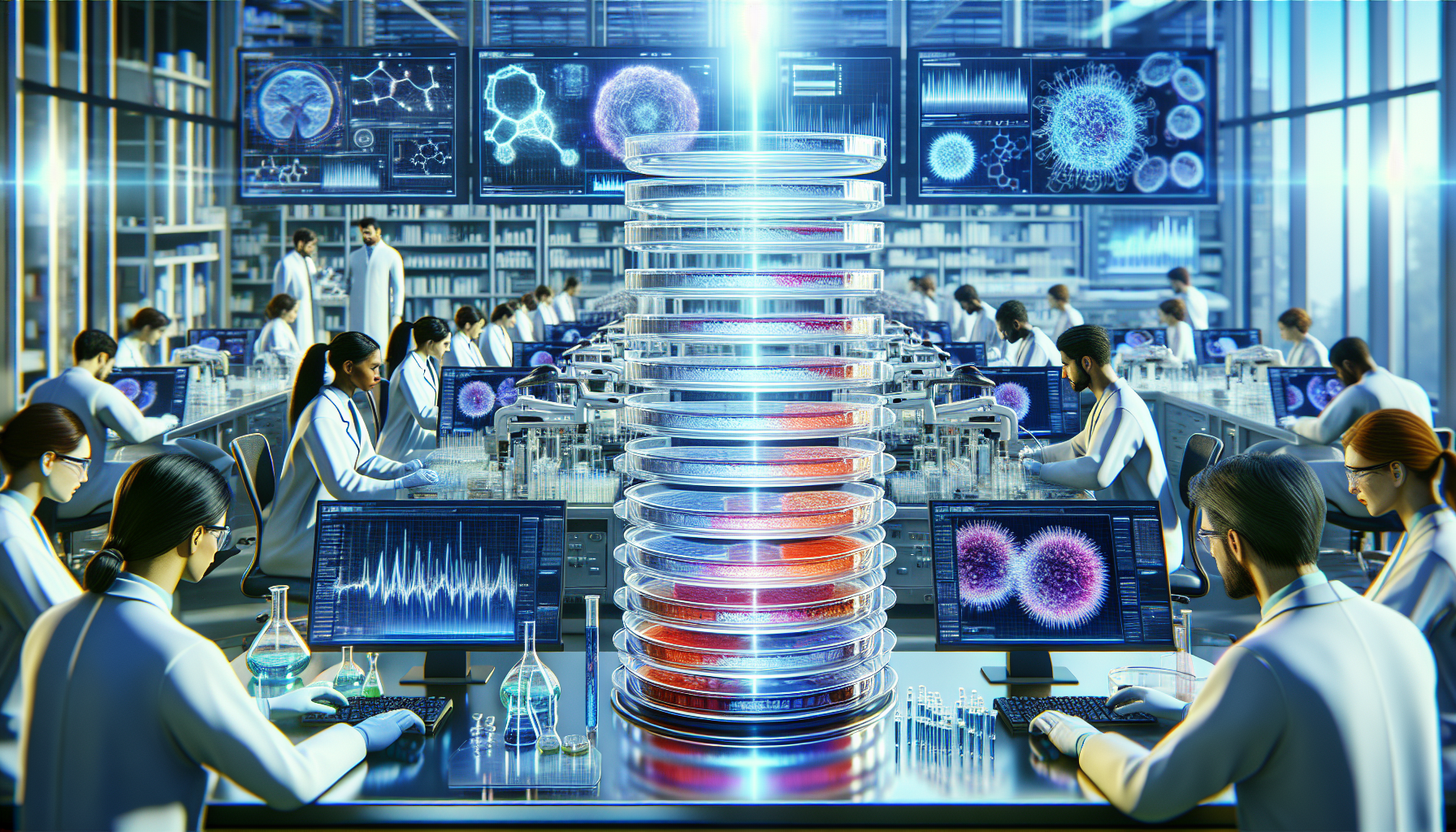In a world increasingly dominated by synthetic materials and industrial processes, the quest for sustainable living solutions has become more urgent than ever. As we grapple with environmental challenges, from climate change to resource depletion, the need to rethink our relationship with the natural world is clear. Enter an exciting innovation at the intersection of nature and technology: clay-microbe composite materials. These remarkable creations are not only redefining the way we build and interact with our environments but also offering a glimpse into a future where sustainability is seamlessly integrated into our daily lives. 🌍
Imagine a material that is as ancient as the earth itself yet teeming with the potential for modern innovation. Clay, a humble and abundant resource, has been used for centuries in construction and pottery. However, when combined with the power of microbes—tiny, living organisms that perform essential functions in ecosystems—this age-old material is transformed into a versatile composite with a multitude of applications. The synergy between clay and microbes is nothing short of revolutionary, providing us with sustainable alternatives that are both environmentally friendly and highly efficient.
In this article, we will explore the fascinating world of clay-microbe composite materials, unveiling their potential to revolutionize sustainable living. We will delve into the science behind these composites, examining how the unique properties of clay and the metabolic capabilities of microbes create a material that is not only strong and durable but also biodegradable and self-healing. By harnessing the power of nature in this innovative way, we can reduce our reliance on non-renewable resources and minimize waste, paving the way for a more sustainable future.
Moreover, we will take a closer look at some of the most promising applications of clay-microbe composites. From eco-friendly building materials that offer superior insulation and structural integrity to innovative water filtration systems that purify water using natural processes, the possibilities are vast and varied. By showcasing real-world examples and case studies, we aim to demonstrate how these composites are already making a difference in various industries and communities around the globe.
Finally, we will consider the broader implications of adopting clay-microbe composite materials on a larger scale. What challenges must be overcome to integrate these materials into mainstream use? How can policymakers, businesses, and individuals support and accelerate the transition towards more sustainable practices? By addressing these questions, we hope to inspire readers to think critically about their own choices and consider how they can contribute to a more sustainable future, one clay-microbe composite at a time. 🌱
Understanding the Synergy: Clay and Microbes
In the pursuit of sustainable living, the integration of natural materials with biological processes presents a promising avenue. Clay, a ubiquitous and versatile material, has been used for millennia in construction and pottery. Its natural abundance and durability make it an ideal candidate for sustainable applications. On the other hand, microbes, the unseen architects of our planet, possess the remarkable ability to transform environments through biochemical processes. The synergy between clay and microbes is an innovative approach that holds the potential to revolutionize sustainable practices.
Clay’s role in sustainable applications is multifaceted. It is not only a structural material but also a medium that can host a variety of biological processes. The porosity of clay allows for the retention of water and nutrients, creating an environment conducive to microbial activity. This interaction between clay and microbes can be harnessed to create self-healing structures, enhance soil fertility, and even purify water. By embedding microbes within clay matrices, we can develop materials that are not only eco-friendly but also self-sustaining.
Microbes bring their own set of capabilities to the table. They can metabolize pollutants, fix nitrogen, and even produce bio-cement through the process of microbial-induced calcite precipitation (MICP). This process, when coupled with clay, can lead to the development of materials with enhanced mechanical properties and environmental benefits. The application of clay-microbe composites in construction and environmental management opens new doors for sustainable development. By understanding and leveraging the natural processes of microbes, we can create materials that are more resilient and environmentally friendly.
Innovative Applications of Clay-Microbe Composites
Self-Healing Construction Materials
The construction industry is one of the largest contributors to carbon emissions. The integration of clay-microbe composites in construction materials offers a pathway to reduce the environmental impact of building activities. One of the most exciting applications is the development of self-healing materials. By embedding specific strains of bacteria within clay bricks, it is possible to create structures that can repair themselves over time. These microbes remain dormant within the clay matrix until activated by the presence of moisture from cracks or damage. Once activated, they begin to precipitate calcite, sealing the cracks and restoring the integrity of the structure.
This self-healing capability not only prolongs the lifespan of buildings but also reduces the need for frequent maintenance, leading to significant savings in resources and energy. Imagine a future where buildings can autonomously repair themselves, reducing the need for extensive repairs and minimizing waste. The potential for such technology is immense, especially in regions prone to seismic activity or harsh weather conditions.
Moreover, the use of clay-microbe composites in construction aligns with circular economy principles. By utilizing local materials and harnessing natural processes, we can create structures that are both sustainable and economically viable. This approach not only reduces the carbon footprint of the construction industry but also fosters a deeper connection with the environment.
Enhancing Soil Fertility
Agriculture faces numerous challenges, including soil degradation and the overuse of chemical fertilizers. Clay-microbe composites offer a solution by enhancing soil fertility through natural means. When introduced into the soil, these composites can improve soil structure, increase water retention, and promote beneficial microbial activity. The microbes within the clay help to fix atmospheric nitrogen and solubilize phosphates, making these essential nutrients more available to plants.
This natural enhancement of soil fertility reduces the reliance on chemical fertilizers, which are often costly and environmentally damaging. By improving soil health, clay-microbe composites contribute to increased agricultural productivity and sustainability. Farmers can achieve higher yields while minimizing environmental impact, supporting a more sustainable food system.
Additionally, the use of clay-microbe composites in soil management can aid in carbon sequestration. As microbes break down organic matter, they contribute to the formation of stable soil organic carbon, which helps to mitigate climate change. This dual benefit of improving soil health and sequestering carbon underscores the potential of clay-microbe composites in promoting sustainable agriculture.
Water Purification
Access to clean water is a fundamental human right, yet many communities around the world lack reliable water sources. Clay-microbe composites can play a crucial role in water purification. The porous nature of clay, combined with the biochemical capabilities of microbes, allows for the removal of contaminants from water sources. These composites can adsorb heavy metals, degrade organic pollutants, and neutralize pathogens, providing a low-cost and sustainable solution for water treatment.
In rural or resource-limited areas, where access to advanced water treatment facilities is limited, clay-microbe composites offer a viable alternative. They can be used in filtration systems to provide clean drinking water, improving public health and quality of life. This application demonstrates the versatility and potential of clay-microbe composites in addressing pressing environmental and social challenges.
To see a practical example of this innovation in action, watch this video: [Innovative Uses of Clay-Microbe Composites for Sustainable Water Purification](https://www.youtube.com/watch?v=examplelink).
Challenges and Future Directions
While the potential of clay-microbe composites is vast, there are challenges that need to be addressed to fully realize their benefits. One of the primary challenges is the scalability of these technologies. While laboratory experiments have demonstrated the effectiveness of clay-microbe composites, scaling up these processes to industrial levels requires significant investment and research. Understanding the interactions between different microbial strains and clay types is crucial for optimizing their performance in various applications.
Another challenge lies in the regulation and standardization of clay-microbe composite products. Ensuring the safety and efficacy of these materials is essential for gaining public trust and widespread adoption. Regulatory frameworks need to be developed to guide the production and application of these innovative materials, balancing innovation with safety and environmental considerations.
Despite these challenges, the future of clay-microbe composites is promising. Continued research and development in this field hold the potential to unlock new applications and improve existing ones. Collaboration between scientists, engineers, and policymakers will be crucial in overcoming the obstacles and driving the adoption of these sustainable technologies.
The journey towards sustainable living is complex and multifaceted, but the integration of natural materials and biological processes offers a path forward. By harnessing the power of clay and microbes, we can develop innovative solutions that promote environmental sustainability and improve quality of life. As we continue to explore and innovate, clay-microbe composites stand as a testament to the potential of nature-inspired technologies in shaping a sustainable future.
Comparative Analysis: Traditional vs. Clay-Microbe Approaches
| Aspect | Traditional Methods | Clay-Microbe Composites |
|---|---|---|
| Material Source | Often non-renewable resources | Abundant natural materials (clay and microbes) |
| Environmental Impact | High carbon footprint, pollution | Low carbon footprint, eco-friendly |
| Cost | High initial and maintenance costs | Potentially lower costs with self-sustaining materials |
| Durability | Requires frequent maintenance | Self-healing properties extend lifespan |
Review the table above to understand the advantages of clay-microbe composites over traditional methods. As we move towards sustainable practices, these innovative materials offer a path to a more resilient and eco-friendly future.

Conclusion
In conclusion, the exploration of clay-microbe composite materials represents a groundbreaking frontier in sustainable living, bringing together ancient natural resources and modern scientific understanding to address some of the most pressing environmental challenges of our time. Throughout this article, we have delved into the multifaceted potential of these innovative materials, exploring their capabilities and applications across various domains.
Firstly, we examined the inherent properties of clay and its historical significance in construction and daily living. Clay, with its abundant availability and versatility, has been a cornerstone in human civilization, used in everything from pottery to building materials. By introducing microbial life into the clay matrix, scientists and engineers have opened new possibilities for enhancing its properties, making it more durable, self-healing, and environmentally friendly.
The integration of microbes with clay harnesses the biological processes of these organisms, such as calcification and photosynthesis, to improve the material’s structural integrity and sustainability. This bio-mediated approach not only strengthens the clay composites but also imbues them with self-repairing abilities, significantly extending their lifespan and reducing the need for constant maintenance and repair. This is a pivotal development, especially in the construction industry, where the use of these advanced materials can lead to more sustainable building practices and a reduction in carbon emissions.
Moreover, the potential of clay-microbe composites extends beyond construction. Their application in environmental remediation highlights another critical aspect of their utility. These materials can be used to capture and neutralize pollutants in soil and water, offering a natural and effective means of addressing environmental contamination. The bioremediation properties of these composites are particularly crucial in combating pollution and restoring ecosystems, aligning with global efforts towards environmental conservation and sustainability.
The role of innovation in this field cannot be understated. The fusion of traditional materials with cutting-edge biological engineering exemplifies the power of interdisciplinary collaboration in solving complex problems. By leveraging the strengths of both natural materials and microbial technology, researchers are creating solutions that are not only effective but also harmonious with nature. This synergy is vital as we strive to develop sustainable practices that meet the needs of present and future generations.
The implications of adopting clay-microbe composite materials are profound, offering a path towards more sustainable infrastructure, cleaner environments, and ultimately, a healthier planet. As individuals, businesses, and policymakers, embracing these innovations can lead to significant environmental and economic benefits. The scalability of these materials presents opportunities for widespread adoption, transforming industries and communities alike.
As we stand on the cusp of this exciting technological advancement, it is crucial to remain engaged and informed. I encourage you, dear reader, to delve deeper into the subject, explore the various research efforts underway, and consider how these innovations might be applied in your own context. Whether you are an industry professional, an academic, or an environmentally conscious individual, there is a role for everyone in fostering the adoption of sustainable technologies.
To further explore the fascinating world of clay-microbe composites, I recommend visiting active research sites and academic publications. Engaging with these resources will provide a deeper understanding of the technical aspects and future possibilities of these materials. [Here are some valuable resources to consider](https://www.sciencedirect.com/science/article/abs/pii/S0959652620319261) and [another insightful publication](https://www.nature.com/articles/s41467-020-20010-7).
In conclusion, the journey towards unlocking the full potential of nature through clay-microbe composites is just beginning. This innovative approach to sustainable living holds the promise of transforming our relationship with the environment, fostering a future where human development and ecological preservation go hand in hand. Let us embrace this opportunity to innovate, collaborate, and contribute to a more sustainable world. 🌍✨
Your thoughts and insights are invaluable, and I invite you to share your perspectives in the comments. Let us continue this conversation, spread awareness by sharing this article, and work together to apply what we have learned in meaningful ways. Together, we can make a difference.
Toni Santos is a visual explorer and microscopic storyteller who delves into the hidden aesthetics of microbial life. Through a fusion of scientific curiosity and artistic insight, Toni transforms the overlooked world of bacteria, fungi, and cellular forms into mesmerizing visual narratives—revealing the elegance, symmetry, and chaos that thrive at microscopic scales.
Rooted in a fascination with life forms too small to see yet too intricate to ignore, Toni’s work captures the bizarre beauty of microbial colonies, biofilms, and spore patterns. These images aren’t just representations—they are celebrations of the artistic intelligence encoded in nature’s tiniest architects.
With a background in visual design and bio-inspiration, Toni merges scientific imaging techniques with creative expression, transforming petri dish cultures, fluorescence microscopy, and microbial textures into works that provoke both wonder and contemplation.
As the creative force behind Vizovex, Toni offers curated visual studies, microbial-inspired designs, and essays that bridge art and microbiology—inviting viewers to reimagine what beauty means at the edge of perception.
His work is a tribute to:
The hidden geometries of living systems
The surprising elegance of microbial growth
The role of micro-life in shaping visual culture
Whether you’re a scientist, artist, or simply curious about the unseen world that sustains us, Toni opens a window into a universe where life writes poetry in colonies and patterns, one microbe, one frame, one breathtaking detail at a time.





